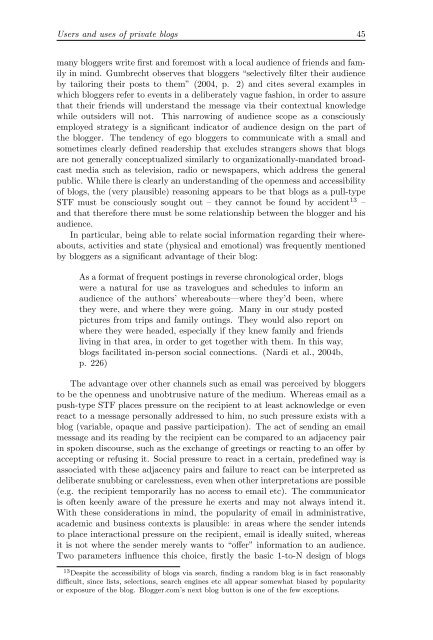The corporate blog as an emerging genre of computer ... - Oapen
The corporate blog as an emerging genre of computer ... - Oapen
The corporate blog as an emerging genre of computer ... - Oapen
You also want an ePaper? Increase the reach of your titles
YUMPU automatically turns print PDFs into web optimized ePapers that Google loves.
Users <strong>an</strong>d uses <strong>of</strong> private <strong>blog</strong>s 45<br />
m<strong>an</strong>y <strong>blog</strong>gers write first <strong>an</strong>d foremost with a local audience <strong>of</strong> friends <strong>an</strong>d family<br />
in mind. Gumbrecht observes that <strong>blog</strong>gers “selectively filter their audience<br />
by tailoring their posts to them” (2004, p. 2) <strong>an</strong>d cites several examples in<br />
which <strong>blog</strong>gers refer to events in a deliberately vague f<strong>as</strong>hion, in order to <strong>as</strong>sure<br />
that their friends will underst<strong>an</strong>d the message via their contextual knowledge<br />
while outsiders will not. This narrowing <strong>of</strong> audience scope <strong>as</strong> a consciously<br />
employed strategy is a signific<strong>an</strong>t indicator <strong>of</strong> audience design on the part <strong>of</strong><br />
the <strong>blog</strong>ger. <strong>The</strong> tendency <strong>of</strong> ego <strong>blog</strong>gers to communicate with a small <strong>an</strong>d<br />
sometimes clearly defined readership that excludes str<strong>an</strong>gers shows that <strong>blog</strong>s<br />
are not generally conceptualized similarly to org<strong>an</strong>izationally-m<strong>an</strong>dated broadc<strong>as</strong>t<br />
media such <strong>as</strong> television, radio or newspapers, which address the general<br />
public. While there is clearly <strong>an</strong> underst<strong>an</strong>ding <strong>of</strong> the openness <strong>an</strong>d accessibility<br />
<strong>of</strong> <strong>blog</strong>s, the (very plausible) re<strong>as</strong>oning appears to be that <strong>blog</strong>s <strong>as</strong> a pull-type<br />
STF must be consciously sought out – they c<strong>an</strong>not be found by accident 13 –<br />
<strong>an</strong>d that therefore there must be some relationship between the <strong>blog</strong>ger <strong>an</strong>d his<br />
audience.<br />
In particular, being able to relate social information regarding their whereabouts,<br />
activities <strong>an</strong>d state (physical <strong>an</strong>d emotional) w<strong>as</strong> frequently mentioned<br />
by <strong>blog</strong>gers <strong>as</strong> a signific<strong>an</strong>t adv<strong>an</strong>tage <strong>of</strong> their <strong>blog</strong>:<br />
As a format <strong>of</strong> frequent postings in reverse chronological order, <strong>blog</strong>s<br />
were a natural for use <strong>as</strong> travelogues <strong>an</strong>d schedules to inform <strong>an</strong><br />
audience <strong>of</strong> the authors’ whereabouts—where they’d been, where<br />
they were, <strong>an</strong>d where they were going. M<strong>an</strong>y in our study posted<br />
pictures from trips <strong>an</strong>d family outings. <strong>The</strong>y would also report on<br />
where they were headed, especially if they knew family <strong>an</strong>d friends<br />
living in that area, in order to get together with them. In this way,<br />
<strong>blog</strong>s facilitated in-person social connections. (Nardi et al., 2004b,<br />
p. 226)<br />
<strong>The</strong> adv<strong>an</strong>tage over other ch<strong>an</strong>nels such <strong>as</strong> email w<strong>as</strong> perceived by <strong>blog</strong>gers<br />
to be the openness <strong>an</strong>d unobtrusive nature <strong>of</strong> the medium. Where<strong>as</strong> email <strong>as</strong> a<br />
push-type STF places pressure on the recipient to at le<strong>as</strong>t acknowledge or even<br />
react to a message personally addressed to him, no such pressure exists with a<br />
<strong>blog</strong> (variable, opaque <strong>an</strong>d p<strong>as</strong>sive participation). <strong>The</strong> act <strong>of</strong> sending <strong>an</strong> email<br />
message <strong>an</strong>d its reading by the recipient c<strong>an</strong> be compared to <strong>an</strong> adjacency pair<br />
in spoken discourse, such <strong>as</strong> the exch<strong>an</strong>ge <strong>of</strong> greetings or reacting to <strong>an</strong> <strong>of</strong>fer by<br />
accepting or refusing it. Social pressure to react in a certain, predefined way is<br />
<strong>as</strong>sociated with these adjacency pairs <strong>an</strong>d failure to react c<strong>an</strong> be interpreted <strong>as</strong><br />
deliberate snubbing or carelessness, even when other interpretations are possible<br />
(e.g. the recipient temporarily h<strong>as</strong> no access to email etc). <strong>The</strong> communicator<br />
is <strong>of</strong>ten keenly aware <strong>of</strong> the pressure he exerts <strong>an</strong>d may not always intend it.<br />
With these considerations in mind, the popularity <strong>of</strong> email in administrative,<br />
academic <strong>an</strong>d business contexts is plausible: in are<strong>as</strong> where the sender intends<br />
to place interactional pressure on the recipient, email is ideally suited, where<strong>as</strong><br />
it is not where the sender merely w<strong>an</strong>ts to “<strong>of</strong>fer” information to <strong>an</strong> audience.<br />
Two parameters influence this choice, firstly the b<strong>as</strong>ic 1-to-N design <strong>of</strong> <strong>blog</strong>s<br />
13 Despite the accessibility <strong>of</strong> <strong>blog</strong>s via search, finding a r<strong>an</strong>dom <strong>blog</strong> is in fact re<strong>as</strong>onably<br />
difficult, since lists, selections, search engines etc all appear somewhat bi<strong>as</strong>ed by popularity<br />
or exposure <strong>of</strong> the <strong>blog</strong>. Blogger.com’s next <strong>blog</strong> button is one <strong>of</strong> the few exceptions.


